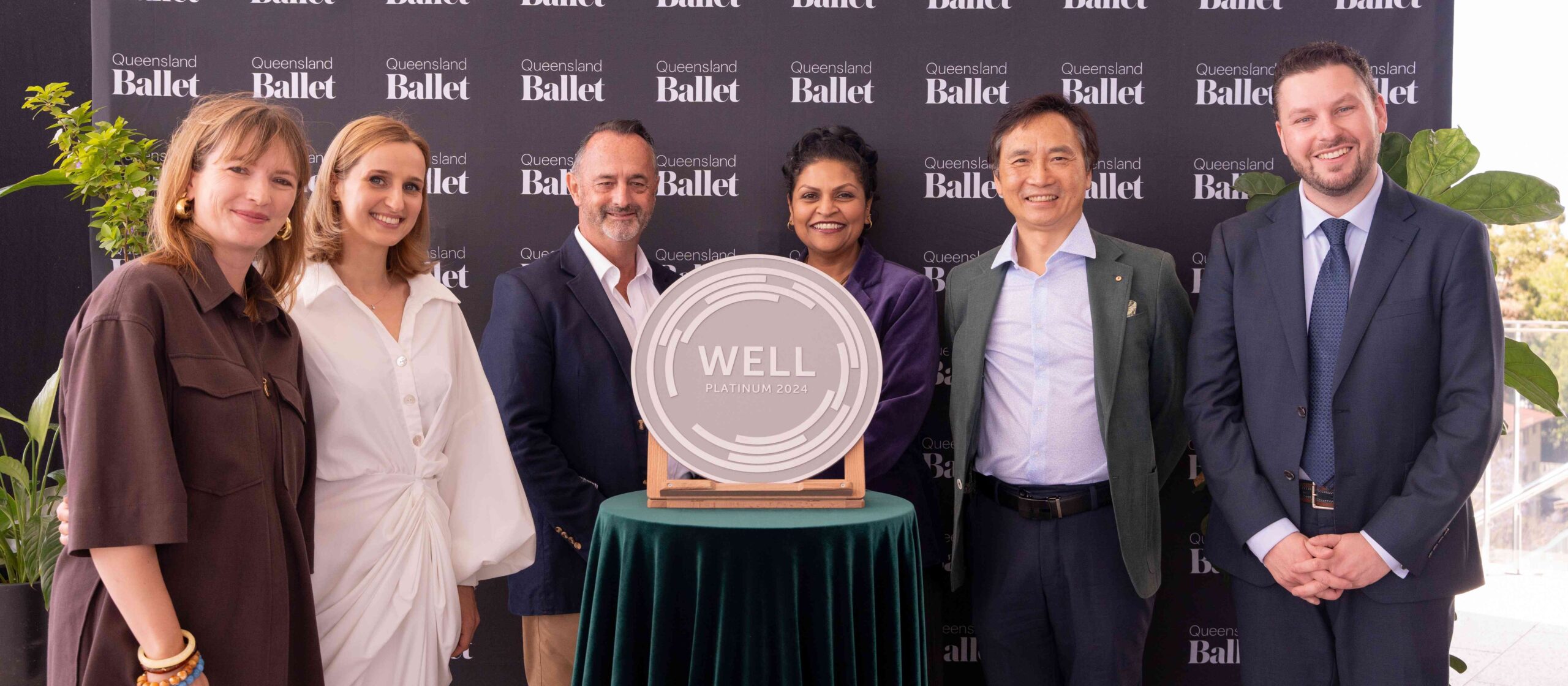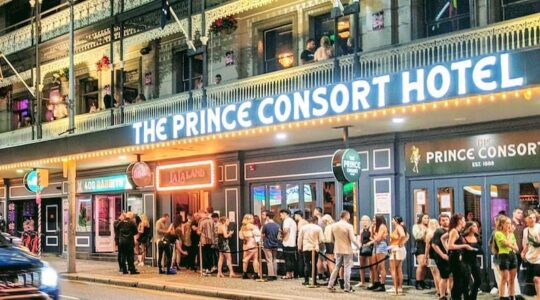Queensland Ballet is renowned for dancers who are in top physical shape, but now its new headquarters is just as fit and healthy as the people who work there.
The Thomas Dixon Centre is the first arts, heritage-listed facility in the world to be awarded the highest healthy building rating by the International WELL Building Standard.
Queensland Ballet WELL project and precincts relations manager Julia Lebiocka, who led the certification process, said they chose to apply for the WELL Platinum level award because it acknowledged the holistic connection between human health and built environments.
“Health and wellbeing are key elements at the heart of Queensland Ballet’s culture, and we believe that people are the company’s greatest asset and, as a result, human health and wellness are the top priority,” Ms Lebiocka said.
With humans now spending an average of 90 percent of their time indoors, Ms Lebiocka said Queensland Ballet wanted to re-design their new building so that it was not only better for the planet, but for their people and visitors.
Queensland Ballet project director and WELL advocate Lucas Gilroy said they were thrilled with the outcome – a far cry from the building’s previous incarnation as a boot factory.
“Thomas Dixon was a bootmaker, he stopped making boots in the 1970s. The building is 110 years old. And after Dixon stopped, it was used by different groups. It was an orchestra at one stage, and was used for government stores,” Mr Gilroy said.
Architectus Conrad Gargett lead architects David Gole and Tamarind Taylor, who designed the Centre, said the WELL certification was integral to the design which in turn had influenced a better design outcome.
“The fact that it is a heritage building added challenges that a new build wouldn’t have – for instance, sustainability aspects, and the physical aspect of providing services and to make them fit into a pre-designed space,” Mr Gole explained.
“We also had challenges relating to scale – making it a space that’s in scale as well as inviting to people and not intimidating.
“It was a seamless task to blend the aspirations of the brief and the opportunities that the WELL program presented really aligned. WELL is part of the day-to-day life of the building, and that’s where it’s different from other accreditations.”
Ms Taylor said WELL encompassed a holistic vision and that’s why it was chosen.
“WELL is not just occupied with the design, but it goes further with its concerns around physical and mental health, and people’s responses to the design. How it looks and feels has been partly shaped by WELL. People love how the building feels,” Ms Taylor said.
“It gave the opportunity to expand and explore the brief and went beyond just ticking the box of green stars.
“It also incorporates additional layers such as the art and lighting, that are normally regarded as accessories, and instead makes it integral to the design.
“A lot of philanthropic investment went into this building. It started as a modest expansion and finished as a much larger project. QB have now got a facility that doesn’t compromise on anything.”
Mr Gole said a key part of the brief was to build a home for the Company and for it to be engaging for the broader community as well as the dancers.
“We wanted the building to be engaging. It’s great to have people visit who don’t know much about ballet and they can get an insight into ballet and the production of ballet,” Mr Gole said.
Xburo building services engineer Ellis Wilson said the building was designed to constantly monitor itself, with each section featuring computer panels on the walls that report the current state of things such as temperature and water quality.
Mr Wilson said there were many competing challenges with designing the engineering for a heritage building and incorporating WELL.
“The air conditioning was a challenge. WELL needs lots of air to meet the Standard, but lots of air being shoved down normal sized ducts will cause noise – something that needs to be mitigated under WELL,” he said.
“This meant we had to increase the size of the ducting, but in an old building, places for storing large ducts are limited. The solution was to go with an ‘industrial chic’ look to make the exposed ducts look good.”
Mr Wilson said the lighting could be adjusted using circadian lighting which involved changing the colour temperature and brightness of lighting at certain times of the day to optimise alertness and stimulate the sleep response.
Rivernet network engineer Gideon Street was responsible for the converged infrastructure.
With more than 22k of IT cabling in the building, that was no mean feat, especially with the heritage building which meant you could not drill holes into the beams or the face of the brickwork.
“We connected all of the electronic systems – computers, phones, lighting controls, AV controls, meeting room controls, and security – so that they could talk to each other,” Mr Street said.
The lighting, for instance, is programmed to start off at a low level and increase during the day. Once a week the building has a low sensory mode, so all of the lights are dimmed and the music is different and this all needed to be programmed in.”
Consultant Damon Fealy was the strategic projects advisor responsible for business and digital transformation.
“I had to outline what a business would look like and what a technology underpinning would look like, and then logically design and network it. It was a flexible framework of requirements,” Mr Fealy said.
The result is 142 separate networks in the building, with thousands of data sensors that talk to each other as a single nervous system – advising on things such as airflow, temperature, Bluetooth connectivity.
“We were able to push the boundaries and deliver multiple levels of coordinated requirements while unpacking the business of ballet and the business of the building,” Mr Fealy said.
Buildings that meet the standard must perform well across 10 categories of air, water, nourishment, light, movement, thermal comfort, sound, materials, mind, and community.
More than 100 performance-based guidelines that began at the beginning of the build stage have carried on through to the daily operations.
WELL incorporates strict rules of architectural design, conditions of the worksite during the build, regular quality checks, operational standards, and company-wide HR policies.
AIR:
The air concept aims to ensure high levels of indoor air quality and minimise human exposure to harmful contaminants.
Ms Lebiocka says all of the air in the building is filtered so that it is 100 percent fresh, with no recirculation – a standard usually provided in hospitals.
The air quality is measured on an hourly basis with 20 monitors mounted on the walls.
Idling in the carpark is also banned, and the air-conditioning filters require regular changes and maintenance.
To qualify for Certification, these elements need to be in place:
- Enhanced Air Quality – all of the air is filtered
- A smoke-free environment
- Enhanced ventilation effectiveness
- Air quality monitoring and awareness
- Combustion minimisation
- Fine air filtration
- Microbe and mould control
- Construction pollution management
Benefits for occupants:
- Reduction of symptoms caused by exposure to air pollutants, such as headaches, dry throat, eye irritation, runny nose, and asthma attacks
- Lowered risk of respiratory and cardiovascular diseases
- Lack of sick building syndrome
- Limitation of smoke pollution
WATER:
Building users are encouraged to drink water and reduce health risks from contaminated water and excessive moisture through awareness and maintenance of water quality and management.
There is a pump room in the basement which filters the water to a high grade, and drinking fountains around the building.
Ms Lebiocka said they had also included fragrance-free soap for those sensitive to fragrance. Paper towels were also used to dry hands because contemporary-style hand dryers which require you to put your hands inside posed a bacterial risk when people don’t wash their hands properly.
Certification requirements:
- Enhanced water quality
- Water contaminants control
- Legionella control
- Water quality consistency
- Drinking water promotion
- Moisture management
- Handwashing support
Benefits:
- High water quality
- No threats to the digestion or immune system
- Easy access to high-quality drinking water
- Limitation of places that harbour germs and a reduction of infectious disease transmission.
NOURISHMENT:
Healthy eating is supported by increasing access to healthier food and beverage choices, limiting access to highly processed food and ingredients, and designing environments that nudge individuals toward healthier choices.
Certification requirements:
- Fruit and vegetable availability
- Nutritional transparency
- Healthy food advertising
- Healthy portion size promotion
- Nutrition education
- Mindful eating
- Special diets accommodation
- Local food environment
Benefits:
- Promotion of healthy eating habits
- Limitation of highly processed food and beverages
- Access to healthy food
- Accommodating a variety of diet requirements
- Lowered risk of diet-related health problems
LIGHT:
The aim with lighting is to provide an environment that reduces circadian phase disruption, improves sleep quality, and positively impacts mood and productivity.
Ms Lebiocka said all lights were on dimmers, with natural daylight a priority, and the placement of desks and lighting were designed to limit glare.
Certification requirements:
- Light exposure and education
- Visual light design and balance
- Circadian lighting design
- Glare control
- Enhanced daylight access
- Electric light quality
- Occupant control of lighting environments
Benefits:
- Circadian rhythm support
- Visual comfort
- Enhanced focus
- Improvement in overall health and wellbeing
MOVEMENT:
Movement is promoted, along with physical activity and active living. Sedentary behaviour is discouraged by creating and enhancing physical activity opportunities throughout the centre.
Ms Lebiocka said the building had been designed to encourage movement, such as the placement of the stairs which you can see when you enter the building.
Certification requirements:
- Active building and communities
- Visual and physical ergonomics
- Movement network and circulation
- Active commuter and occupant support such as bike racks and end of trip facilities for showering before entering the office
- Site planning and selection
- Physical activity opportunities such as free dance, fitness, or yoga classes for staff
- Active furnishings such as sit-stand desks
- Physical activity spaces and equipment
- Exterior active design
Benefits:
- Active transport facilities
- Promotion of physical activity within the workplace
- Discouragement of sedentary behaviour
- Access to free fitness programs
- Decreased likelihood of health outcomes including obesity, type 2 diabetes, and cardiovascular risks
THERMAL COMFORT:
Individual thermal comfort is enhanced to support human health, well-being and productivity. The building temperature is set between 21-25 degrees celsius, depending on the season and humidity. There are baskets with blankets, USB powered fans, and the ability to change the temperature in every room.
Ms Lebiocka said they also had the ability to switch off the air conditioning in parts of the building they do not use, such as when the dancers are at QPAC and the facilities aren’t being used.
Certification requirements:
- Thermal performance
- Individual thermal control
- Humidity control
Benefits:
- Adjustable thermal environment
- Increased comfort
- Decreased symptoms associated with sick building syndrome
SOUND:
Acoustic comfort is provided for the purpose of improving general health and well-being.
Ms Lebiocka said there were rigorous standards around how much reverberation was allowed in each room.
Certification requirements:
- Sound mapping
- Maximum noise levels
- Sound barriers
- Sound absorption
Benefits:
- Acoustic comfort
- Designated spaces for social interactions, focused work and collaboration
- Focus support
MATERIALS:
The aim with materials is to reduce the risk of exposure to environmental contamination and promote the choice of safe ingredients.
Certification requirements:
- Fundamental material precautions
- Hazardous material abatement
- Outdoor structures
- Waste management
- In-place management
- Site remediation
- Pesticides use
- Hazardous material reduction
- Cleaning products and protocols
Benefits:
- Advancing health through the limitation of exposure to harmful chemicals and materials
- Promotion of safe ingredients
- Mitigation of environmental contamination
MIND:
The mind concept supports cognitive and emotional health through a variety of prevention and treatment efforts, including building design, and policy and program strategies.
Certification requirements:
- Mental health promotion
- Enhanced access to nature
- Mental health support
- Mental health education
- Stress support
- Restorative opportunities
- Restorative spaces and programming
- Focus support
Benefits:
- Access to programs supporting mental wellbeing and overall health
- Increased focus and productivity
- Promotion of healthy lifestyle choices
- Lessened irritability and stress
COMMUNITY:
The aim with community is to implement strategies that address public health issues, focusing on the social components. These drive and shape health, and form built spaces that create a foundation for equitable, inclusive and healthy environments.
Mr Gilroy said everyone who worked on the building had enjoyed ownership of it in various ways.
“Seeing it come alive, after it was run down two storey building is rewarding,” Mr Gilroy said.
“The man who worked on the brass handrails on the staircase would stay after hours and re-do any work that wasn’t up to par. He was only 21 years old and had taught himself to weld watching YouTube videos and using his grandfather’s welder. When the building opened he brought his grandmother who raised him to see his work.”
Certification requirements:
- Health and wellness awareness
- Integrative design
- Occupant surveying
- Community immunity
- New parent support
- New mother support
- Accessibility and universal design
- Accessible bathroom accommodation
- Emergency preparedness
- Community access and engagement
Benefits:
- Inclusive and accessible environment
- Promotion of health and equitable spaces and employment conditions
- Building health and wellbeing awareness
- Enhanced wellbeing and health support in a built environment








